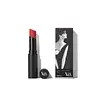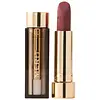V&A Beauty Rouge Essential Lipstick Matte Versus Merit Beauty Signature Lip Lightweight Matte Lipstick
What's inside
What's inside
 Key Ingredients
Key Ingredients

 Benefits
Benefits

 Concerns
Concerns

 Ingredients Side-by-side
Ingredients Side-by-side

Dimethicone
EmollientSynthetic Wax
AbrasiveNeopentyl Glycol Diheptanoate
EmollientPolypropylsilsesquioxane
Isoeicosane
EmollientPolymethylsilsesquioxane
Polyglyceryl-2 Triisostearate
EmulsifyingCaprylic/Capric Triglyceride
MaskingIsononyl Isononanoate
EmollientDiisostearyl Malate
EmollientDimethicone/Vinyl Dimethicone Crosspolymer
Skin ConditioningRicinus Communis Seed Oil
MaskingCI 15985
Cosmetic ColorantSilica
AbrasiveAmylopectin
Microcrystalline Wax
Emulsion StabilisingCI 15850
Cosmetic ColorantPolyglyceryl-2 Diisostearate
EmulsifyingBoron Nitride
AbsorbentHyaluronic Acid
HumectantCI 45410
Cosmetic ColorantHydrogenated Olive Oil
Skin ConditioningOlea Europaea Fruit Oil
MaskingHydrogenated Olive Oil Unsaponifiables
EmollientOenothera Biennis Oil
EmollientRosa Damascena Flower Extract
MaskingRosmarinus Officinalis Leaf Extract
AntimicrobialRosa Canina Fruit Extract
AstringentHydrogenated Castor Oil
EmollientDiglyceryl Sebacate/Isopalmitate
EmollientCetyl Ethylhexanoate
EmollientEthylene/Propylene Copolymer
AbrasivePolyhydroxystearic Acid
EmulsifyingStearalkonium Hectorite
Gel FormingCI 77220
Cosmetic ColorantSucrose Tetrastearate Triacetate
EmollientGlyceryl Caprylate
EmollientPropylene Carbonate
SolventEthylhexyl Palmitate
EmollientIsopropyl Myristate
EmollientIsostearic Acid
CleansingLecithin
EmollientPolyglyceryl-3 Polyricinoleate
EmulsifyingWater
Skin ConditioningTocopherol
AntioxidantButylene Glycol
HumectantGlycerin
Humectant1,2-Hexanediol
Skin ConditioningEthylhexylglycerin
Skin ConditioningParfum
MaskingCI 77499
Cosmetic ColorantDimethicone, Synthetic Wax, Neopentyl Glycol Diheptanoate, Polypropylsilsesquioxane, Isoeicosane, Polymethylsilsesquioxane, Polyglyceryl-2 Triisostearate, Caprylic/Capric Triglyceride, Isononyl Isononanoate, Diisostearyl Malate, Dimethicone/Vinyl Dimethicone Crosspolymer, Ricinus Communis Seed Oil, CI 15985, Silica, Amylopectin, Microcrystalline Wax, CI 15850, Polyglyceryl-2 Diisostearate, Boron Nitride, Hyaluronic Acid, CI 45410, Hydrogenated Olive Oil, Olea Europaea Fruit Oil, Hydrogenated Olive Oil Unsaponifiables, Oenothera Biennis Oil, Rosa Damascena Flower Extract, Rosmarinus Officinalis Leaf Extract, Rosa Canina Fruit Extract, Hydrogenated Castor Oil, Diglyceryl Sebacate/Isopalmitate, Cetyl Ethylhexanoate, Ethylene/Propylene Copolymer, Polyhydroxystearic Acid, Stearalkonium Hectorite, CI 77220, Sucrose Tetrastearate Triacetate, Glyceryl Caprylate, Propylene Carbonate, Ethylhexyl Palmitate, Isopropyl Myristate, Isostearic Acid, Lecithin, Polyglyceryl-3 Polyricinoleate, Water, Tocopherol, Butylene Glycol, Glycerin, 1,2-Hexanediol, Ethylhexylglycerin, Parfum, CI 77499
Dimethicone
EmollientEthylhexyl Palmitate
EmollientSynthetic Wax
AbrasiveCI 77220
Cosmetic ColorantCaprylic/Capric Triglyceride
MaskingHydrogenated Olive Oil
Skin ConditioningKaolin
AbrasivePolyglyceryl-3 Diisostearate
EmulsifyingSilica
AbrasiveEuphorbia Cerifera Wax
Olea Europaea Fruit Oil
MaskingOlea Europaea Oil Unsaponifiables
Skin ConditioningSodium Hyaluronate
HumectantSesamum Indicum Seed Extract
Skin ConditioningTocopherol
AntioxidantStearalkonium Hectorite
Gel FormingDimethicone/Vinyl Dimethicone Crosspolymer
Skin ConditioningRicinus Communis Seed Oil
MaskingDimethyl Isosorbide
SolventPropylene Carbonate
SolventIsopropyl Titanium Triisostearate
EmollientHydrogenated Castor Oil
EmollientTitanium Dioxide
Cosmetic ColorantIron Oxides
CI 15850
Cosmetic ColorantCI 45410
Cosmetic ColorantCI 73360
Cosmetic ColorantCI 19140
Cosmetic ColorantCI 15985
Cosmetic ColorantCI 42090
Cosmetic ColorantDimethicone, Ethylhexyl Palmitate, Synthetic Wax, CI 77220, Caprylic/Capric Triglyceride, Hydrogenated Olive Oil, Kaolin, Polyglyceryl-3 Diisostearate, Silica, Euphorbia Cerifera Wax, Olea Europaea Fruit Oil, Olea Europaea Oil Unsaponifiables, Sodium Hyaluronate, Sesamum Indicum Seed Extract, Tocopherol, Stearalkonium Hectorite, Dimethicone/Vinyl Dimethicone Crosspolymer, Ricinus Communis Seed Oil, Dimethyl Isosorbide, Propylene Carbonate, Isopropyl Titanium Triisostearate, Hydrogenated Castor Oil, Titanium Dioxide, Iron Oxides, CI 15850, CI 45410, CI 73360, CI 19140, CI 15985, CI 42090
Ingredients Explained
These ingredients are found in both products.
Ingredients higher up in an ingredient list are typically present in a larger amount.
This ingredient is an emollient, solvent, and texture enhancer. It is considered a skin-softener by helping the skin prevent moisture loss.
It helps thicken a product's formula and makes it easier to spread by dissolving clumping compounds.
Caprylic Triglyceride is made by combining glycerin with coconut oil, forming a clear liquid.
While there is an assumption Caprylic Triglyceride can clog pores due to it being derived from coconut oil, there is no research supporting this.
Learn more about Caprylic/Capric TriglycerideCi 15850 is the pigment color red. It is an azo dye and created synthetically.
Azo dyes need to be thoroughly purified before use. This allows them to be more stable and longer-lasting.
This ingredient is common in foundations, lipsticks, and blushes. This color is described as brown/orangey red.
It has many secondary names such as Red 6 and Red 7. According to a manufacturer, Red 6 usually contains aluminum.
Learn more about CI 15850Ci 15985 is a dye made from petroleum. It is synthetically created and approved by the FDA for use in foods and cosmetics.
The color of this dye is orange/yellow.
This ingredient can be found in makeup, sun care, and skincare.
Learn more about CI 15985CI 45410 is a synthetic red-pigment and dye.
It often goes by both Red 28 or Red 27; manufacturers label both ingredients as CI 45410.
This dye is commonly found in makeup because it imparts a vivid color. Some types of this dye change color based on pH level and interaction with moisture:
Your skin has a natural pH of around 4.5 - 5.5.
According to the FDA, CI 45410 is not permitted for use in eye products.
Red 27 is a flourescein dye and commonly used as a fluorescent tracer in medicine.
Learn more about CI 45410We don't have a description for CI 77220 yet.
Dimethicone is a type of synthetic silicone created from natural materials such as quartz.
What it does:
Dimethicone comes in different viscosities:
Depending on the viscosity, dimethicone has different properties.
Ingredients lists don't always show which type is used, so we recommend reaching out to the brand if you have questions about the viscosity.
This ingredient is unlikely to cause irritation because it does not get absorbed into skin. However, people with silicone allergies should be careful about using this ingredient.
Note: Dimethicone may contribute to pilling. This is because it is not oil or water soluble, so pilling may occur when layered with products. When mixed with heavy oils in a formula, the outcome is also quite greasy.
Learn more about DimethiconeThis ingredient is a silicone used to improve the texture of products and absorb oil. It does not get absorbed into the skin.
Like other silicones, Dimethicone/Vinyl Dimethicone Crosspolymer helps condition the skin by creating a barrier. In this sense, it can act as an emollient and trap moisture in.
This ingredient is a type of elastomer.
Learn more about Dimethicone/Vinyl Dimethicone CrosspolymerEthylhexyl Palmitate, also known as octyl palmitate, is created from 2-ethylhexyl alcohol and palmitic acid. It is a fatty acid ester.
The fatty acid content of Ethylhexyl Palmitate makes it an emollient. Emollients help soften and hydrate your skin by trapping moisture within.
Ethylhexyl Palmitate is also used to help improve the texture of cosmetics. It helps other ingredient dissolve in products and help disperse ingredients more evenly.
You'll likely find this ingredient in sunscreen, as it is often used to mix UV-blocking ingredients such as avobenzone and ethylhexyl triazone.
It can also help stabilize the fragrances in a product as a fragrance fixative.
Ethylhexyl Palmitate can be used to substitute mineral oil.
Due to its high fatty acid content, it may not be fungal-acne safe.
Learn more about Ethylhexyl PalmitateHydrogenated Castor Oil is created by adding hydrogen to castor oil. This helps stabilize the castor oil and raises the melting point. At room temperature, hydrogenated castor oil is solid.
Castor Oil helps moisturize the skin. It is rich in a fatty acid called ricinoleic acid. This fatty acid helps prevent moisture loss on the skin. This helps keep your skin soft and hydrated. Ricinoleic acid also has anti-inflammatory and pain reducing properties.
As a wax-like substance, Hydrogenated Castor Oil acts as an emollient. Emollients help keep your skin stay soft and smooth by creating a barrier. This barrier helps trap moisture.
Hydrogenated Castor Oil may not be fungal-acne safe. We recommend speaking with a professional.
Learn more about Hydrogenated Castor OilHydrogenated Olive Oil is created from adding hydrogen to olive oil. This creates more stability.
The primary contents of olive oil are glycerides of the fatty acids linoleic, oleic and palmitic.
Olive oil also contains antioxidants such as Vitamin E. Antioxidants may help reduce signs of aging by fighting unstable free-radical molecules. It also contains Vitamins A (retinol), D, and K.
Learn more about Hydrogenated Olive OilOlea Europaea Fruit Oil is the fixed oil obtained from the ripe fruit of the Olive. In other words - olive oil.
The primary contents of olive oil are glycerides of the fatty acids linoleic, oleic and palmitic.
Olive oil also contains antioxidants such as Vitamin E. Antioxidants may help reduce signs of aging by fighting unstable free-radical molecules. It also contains Vitamins A (retinol), D, and K.
The squalene in olive oil makes it a great emollient. Emollients help soothe and soften your skin by trapping moisture in. This makes olive oil a great skin moisturizer.
Studies show olive oil to have antibacterial and antifungal properties in low concentrations. Another study found olive oil irritated sensitive oily skin. We always recommend speaking with a professional about using this ingredient in your routine.
Due to the fatty acid content, this ingredient may not be fungal-acne safe.
Learn more about Olea Europaea Fruit OilThis ingredient is a solvent. It helps dissolve active ingredients and alter the texture of products.
Propylene Carbonate is commonly used in makeup and with clay, such as montmorillonite or bentonite.
Studies show this ingredient to be safe for cosmetics. When it is undiluted, it can cause skin irritation. (It is always diluted in skincare and makeup). This ingredient is water-soluble.
Propylene Carbonate is created from propylene glycol and carbonic acid.
Learn more about Propylene CarbonateRicinus Communis Seed Oil is the INCI name for castor oil.
Castor Oil helps moisturize the skin. It is rich in a fatty acid called ricinoleic acid. This fatty acid helps prevent moisture loss on the skin. This helps keep your skin soft and hydrated. Ricinoleic acid also has anti-inflammatory and pain reducing properties.
Besides hydrating the skin, castor oil is also used to hydrate hair. By keeping the hair shaft moisturized, breakage is decreased. More studies are needed to show castor oil's effective on stimulating hair growth.
Castor oil is created by cold-pressing castor seeds and then purifying the oil with heat. It was used in Ancient Egypt as fuel in lamps and to help treat eye irritation.
The term 'fragrance' is not regulated in many countries. In many cases, it is up to the brand to define this term. For instance, many brands choose to label themselves as "fragrance-free" because they are not using synthetic fragrances. However, their products may still contain ingredients such as essential oils that are considered a fragrance.
Learn more about Ricinus Communis Seed OilSilica, also known as silicon dioxide, is a naturally occurring mineral. It is used as a fine, spherical, and porous powder in cosmetics.
Though it has exfoliant properties, the function of silica varies depending on the product.
The unique structure of silica enhances the spreadability and adds smoothness, making it a great texture enhancer.
It is also used as an active carrier, emulsifier, and mattifier due to its ability to absorb excess oil.
In some products, tiny microneedles called spicules are made from silica or hydrolyzed sponge. When you rub them in, they lightly polish away dead skin layers and enhance the penetration of active ingredients.
Learn more about SilicaStearalkonium Hectorite is a clay-derived ingredient used to thicken a product and help create a gel-like texture.
Synthetic Wax is created from fossil fuels such as natural gas. It is used to enhance texture, adjust pH, and as an occlusive.
It may also be used as an abrasive ingredient to exfoliate the skin.
Synthetic Wax may not be fungal acne safe.
Learn more about Synthetic WaxTocopherol (also known as Vitamin E) is a common antioxidant used to help protect the skin from free-radicals and strengthen the skin barrier. It's also fat soluble - this means our skin is great at absorbing it.
Vitamin E also helps keep your natural skin lipids healthy. Your lipid skin barrier naturally consists of lipids, ceramides, and fatty acids. Vitamin E offers extra protection for your skin’s lipid barrier, keeping your skin healthy and nourished.
Another benefit is a bit of UV protection. Vitamin E helps reduce the damage caused by UVB rays. (It should not replace your sunscreen). Combining it with Vitamin C can decrease sunburned cells and hyperpigmentation after UV exposure.
You might have noticed Vitamin E + C often paired together. This is because it is great at stabilizing Vitamin C. Using the two together helps increase the effectiveness of both ingredients.
There are often claims that Vitamin E can reduce/prevent scarring, but these claims haven't been confirmed by scientific research.
Learn more about Tocopherol